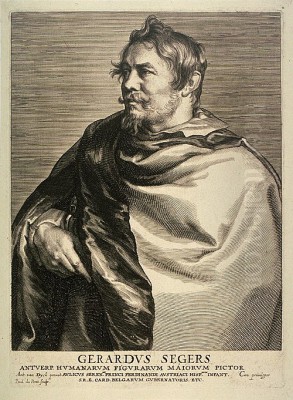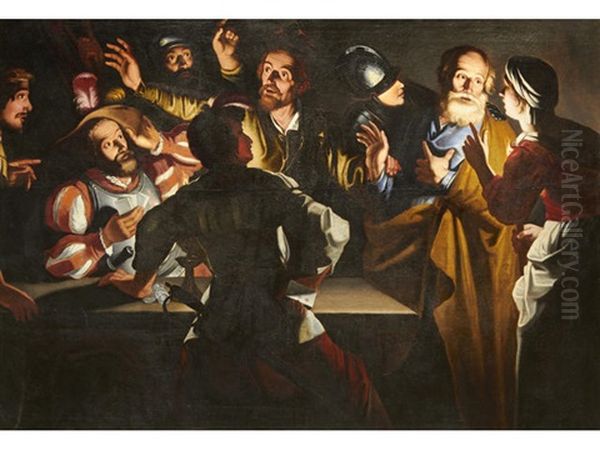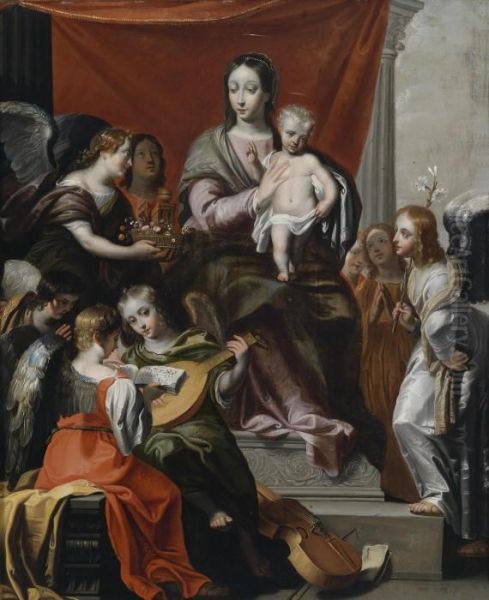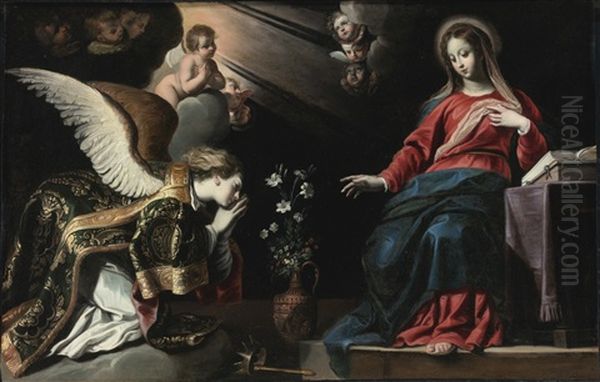
Gerard Seghers stands as a significant figure in the landscape of Flemish Baroque painting. Active during a vibrant period of artistic production, he navigated the powerful influences of his time, forging a distinct path that blended dramatic intensity with refined elegance. His life and work offer a fascinating glimpse into the artistic currents of the Southern Netherlands in the early 17th century.
Early Life and Training in Antwerp
Born in Antwerp in 1591, Gerard Seghers entered a city that was a major European art center. His artistic education began under the tutelage of prominent local masters. Sources suggest he may have studied with either Abraham Janssens or Hendrick van Balen, both respected painters who would have provided him with a solid foundation in the Flemish tradition.
Seghers demonstrated remarkable talent early on. By the age of seventeen, a testament to his precocious skill, he was accepted as a master into the prestigious Antwerp Guild of Saint Luke. This membership marked his official entry into the professional world of painting in one of Europe's most competitive artistic hubs.
The Italian Journey and the Embrace of Caravaggism
Around 1611, Seghers embarked on a journey that would profoundly shape his artistic vision: a trip to Italy that lasted until approximately 1620. This period was crucial for his development, exposing him to the revolutionary works of Michelangelo Merisi da Caravaggio and his followers, known as the Caravaggisti.
In Italy, particularly in Rome, Seghers absorbed the key elements of Caravaggio's style: the dramatic use of chiaroscuro (strong contrasts between light and dark), tenebrism (where darkness dominates the canvas), realistic depictions of figures, and intense emotional narratives. The works of Bartolomeo Manfredi, a leading interpreter of Caravaggio's style, are noted as having had a particularly deep impact on the young Flemish painter.
Seghers's time in Italy positioned him among the relatively few artists from the Southern Netherlands to fully embrace and adapt the Caravaggist aesthetic. This influence is clearly visible in the works he produced during and immediately following his Italian sojourn.
Return to Flanders and Stylistic Maturation

Upon returning to Antwerp around 1620, Seghers brought the dramatic intensity of Italian Caravaggism back to his homeland. He initially established himself as one of the foremost Flemish Caravaggisti, creating powerful religious scenes characterized by their stark lighting and emotional force.
A prime example from this period is his The Denial of St. Peter, painted around 1625. This work likely showcased the hallmarks of his Caravaggesque phase: a dimly lit setting, figures emerging from shadow, and a focus on the psychological tension of the biblical narrative.
However, Seghers's style was not static. Over time, particularly after the 1620s, his work began to evolve. While retaining a sense of drama, he gradually moved away from the starkness of his earlier Caravaggist works towards a style that incorporated the influence of Antwerp's dominant artistic figure: Peter Paul Rubens.
The Influence of Rubens and Later Style
The towering presence of Peter Paul Rubens in Antwerp was inescapable. Seghers, like many of his contemporaries, absorbed elements of Rubens's dynamic compositions, richer color palettes, and more fluid brushwork. This shift did not necessarily mean abandoning his earlier influences but rather integrating them into a more refined, perhaps more typically Flemish Baroque, manner.
His later works often display a greater elegance in composition, more harmonious color schemes, and smoother transitions between light and shadow compared to the stark contrasts of his purely Caravaggesque phase. The intense drama became tempered with a sense of solemnity and introspection. This evolution contributed to his growing success and reputation.
Following the death of Rubens in 1640, Gerard Seghers rose to prominence, becoming one of the most popular and financially successful artists in Antwerp. He effectively stepped into the void left by the master, securing major commissions and enjoying widespread patronage.
Major Themes and Representative Works
Religious subjects formed the core of Gerard Seghers's oeuvre. He was particularly renowned for his large-scale altarpieces, commissioned for churches and monastic institutions throughout the Southern Netherlands, including prominent locations in Antwerp, Ghent, and Leuven. These works allowed him to explore profound spiritual themes with emotional depth.
Several key works illustrate his artistic range and stylistic development:
The Denial of St. Peter (c. 1625): Representative of his early, powerful Caravaggist style, focusing on dramatic lighting and psychological intensity. Its current location is not specified in the source texts but it likely resides in a museum or private collection.

The Assumption of the Virgin (1629): An important altarpiece, noted as being housed in the Musée Fabre in Montpellier, though another source mentions a work of this title in the Grenoble Museum of Fine Arts. This piece would likely reflect his evolving style, possibly blending Caravaggesque elements with a growing Rubenesque influence.
Christ Returning from Purgatory to Greet his Mother (c. 1640s): This painting exemplifies his later, more solemn style. It depicts the sacred reunion with dignity and emotional resonance, showcasing elegant composition and harmonious colors. It is currently held in the Royal Museum of Fine Arts, Antwerp (Inventory No. 308).
John the Evangelist Administering Communion to the Virgin Mary (c. 1640s): Another work from his mature period, this piece portrays the solemn religious ritual with fine brushwork and rich coloration, emphasizing piety and grace. It is housed in the Kunsthistorisches Museum in Vienna (Inventory No. 308).
St. John with a Lamp: Mentioned as being in the Kunsthistorisches Museum, Vienna, this work likely also reflects his mastery of light and shadow, possibly in a more intimate, focused composition typical of Caravaggesque single-figure studies.
Beyond large altarpieces, Seghers also engaged with history painting and portraiture, consistently demonstrating a skill for conveying human emotion with subtlety and power.
A Multifaceted Professional: Artist, Dealer, and Advisor
Gerard Seghers was not only a prolific painter but also an astute figure in the broader art world of his time. He operated successfully as an art collector and dealer, leveraging his expertise and connections. His activities extended beyond simply creating art; he played a significant role in the art market.
His reputation reached international levels. He is known to have worked for Spanish patrons, including the Duke of Victoria and Antonio Zapata, who served as a diplomat in Catania. Furthermore, records indicate his involvement in art projects for King Philip III of Spain, highlighting his participation in the international art trade and his connections with powerful European courts. His dealings likely extended across Flanders, Spain, and Italy.
Seghers also served as an art advisor, providing expertise to religious institutions and city authorities. His standing in the artistic community is further evidenced by his collaborations, such as working alongside Rubens on decorative projects for Antwerp churches. He also seems to have promoted the works of other artists, acting in a capacity similar to a gallery agent. His service to the Italian Piccolomini family underscores his active presence in Italian art circles as well.
Interactions with Contemporary Artists

Seghers's career unfolded amidst a rich network of fellow artists, writers, and patrons. His interactions reveal his position within the cultural milieu of the Baroque era:
Peter Paul Rubens: Seghers maintained a close relationship, likely a friendship, with Rubens. He was significantly influenced by the older master and became one of his most prominent successors in Antwerp's art scene after Rubens's death in 1640. A work like Seghers's Madonna (1630) is cited as showing Rubens's influence.
Abraham Janssens and Hendrick van Balen: These were his likely early teachers, grounding him in the Antwerp tradition before his Italian journey.
Bartolomeo Manfredi: A key Italian Caravaggist whose work deeply impacted Seghers's adoption of the style during his time in Italy.
Jan Willemszoon van Oldenrijk: Seghers collaborated with this Dutch still life painter, suggesting connections and perhaps influence extending into that genre.
Constantijn Huygens: His correspondence with this influential Dutch writer and diplomat indicates Seghers's respected status within the wider cultural sphere of the Low Countries.
Bartolomé Pérez: Seghers's work is noted as having influenced this Spanish still life painter, demonstrating the reach of his artistic impact.
Artus Quellinus and Jan-Philips van Thienen: Collaboration with the prominent sculptor Artus Quellinus the Elder and his associate (or son, sources vary) Jan-Philips van Thienen points to Seghers's engagement with artists across different media within the Baroque movement.
These connections illustrate a dynamic career embedded within the artistic exchanges of the 17th century.
Family Life and Artistic Legacy
Beyond his professional life, Gerard Seghers had a substantial family. He married Catharina Wouters, and together they had eleven children. This large family suggests a stable domestic life alongside his busy artistic career.
Artistic talent appears to have run in the family. His brother, Jan Baptist Seghers, was also a painter who became a master in the Antwerp guild in 1647. Sources suggest Jan Baptist was influenced by Gerard and received support from their father. Additionally, one of Gerard's own sons, also named Jan-Baptist Seghers, followed in his father's footsteps and became a painter, carrying on the family's artistic tradition.
Art Historical Evaluation and Significance
Art historians regard Gerard Seghers as a pivotal figure among the Flemish Caravaggisti. He played a crucial role in transmitting the dramatic realism and lighting techniques of Caravaggio to the Southern Netherlands. His early work stands as some of the most compelling examples of this style produced outside of Italy.
His subsequent stylistic evolution, marked by the integration of Rubens's influence, demonstrates his adaptability and his engagement with the prevailing artistic trends in Flanders. This fusion resulted in a mature style that combined the psychological intensity and chiaroscuro of Caravaggism with the dynamism, richer color, and painterly elegance characteristic of the Flemish High Baroque championed by Rubens.
While perhaps not as universally famous today as Rubens or Van Dyck, Seghers was highly esteemed in his own time, achieving significant success and influence. His works, though relatively limited in number compared to some contemporaries, are valued for their technical skill, emotional depth, and their unique position bridging Italianate drama and Flemish painterly traditions. He remains an important artist for understanding the complexities and cross-currents of 17th-century European art. His legacy lies in his powerful religious imagery and his successful synthesis of major Baroque stylistic trends.